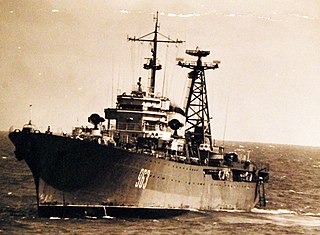
The Don-class submarine tender was the NATO reporting name for a group of seven submarine tenders built for the Soviet Navy in the late 1950s. The Soviet designation was Project 310 Batur. Evolving from a need for dispersed basing of submarines in the advent of a nuclear war, the ships were designed to support distant operations of the Soviet Union's submarine fleet, capable of repairing and resupplying. However, the Soviets returned to stationary basing of their submarines and the Don class were later converted into flagships. One vessel was exported to Indonesia in 1962 and due to the ship's heavy armament, was used primarily for patrol duties. The ships of the Don class were removed from service in the mid 1990s and broken up for scrap.

Kronstadt was a Project 1134A Kresta II-class cruiser of the Soviet Navy, named for the Kronstadt naval base. The first ship of her class, the ship served during the Cold War, from 1969 to 1991. She served with the Northern Fleet, with her shakedown cruise being through the Mediterranean Sea. After colliding with a destroyer in 1975, she spent five years being repaired and modernized. She was decommissioned in 1991 before being sold for scrap two years later due to reduced naval funding and deteriorating conditions.

Admiral Makarov was a Project 1134A Berkut A class cruiser of the Soviet Navy and briefly of the Russian Navy. The fourth ship of her class, the ship served mostly during the Cold War, from 1972 to 1992. She served with the Northern Fleet for the duration of her career, often operating in the Atlantic and the Mediterranean in order to show the flag, and was refitted between 1983 and 1985. She was decommissioned in 1992 due to deteriorating conditions which reduced naval funding prevented from being addressed before being sold for scrap in 1994.

Vasily Chapayev was a Project 1134A Berkut A class cruiser of the Soviet Navy named for Soviet commander Vasily Chapayev. The ninth ship of the class, the vessel was launched in 1974 and served during the Cold War with the Pacific Fleet. Based at Vladivostok, the ship travelled extensively in the Indian and Pacific Oceans, visiting a large number of friendly ports in Angola, Ethiopia, India, Mozambique and Yemen. In 1978 and 1979, the vessel formed part of a flotilla of Soviet vessels including the Project 68bis cruiser Admiral Senyavin that supported Vietnam in the aftermath of the Sino-Vietnamese War. In 1982, Vasily Chapayev was allocated to support the BOR-4 spaceplane programme. 1985 found the vessel undertaking anti-submarine exercises against US Navy submarines demonstrating the Soviet capability of joint operations between aircraft, ships and submarines, which expanded the following year to a dummy attack on the US base at Pearl Harbor. In 1986, the ship took part in the first joint exercises between the Soviet and North Korean Navies. Taken out of active service in 1992, Vasily Chapayev was decommissioned and transferred to be broken up in 1993.

Magomed Gadzhiev was a Don-class submarine tender of the Soviet Navy.

Magadansky Komsomolets was a Don-class submarine tender of the Soviet Navy.

Nikolay Kartashov was a Don-class submarine tender of the Soviet Navy which later was transferred to the Indonesian Navy and renamed KRI Ratulangi.

Fyodor Vidyaev was a Don-class submarine tender of the Soviet Navy.

Viktor Kotelnikov was a Don-class submarine tender of the Soviet Navy.

Batur was a Don-class submarine tender of the Soviet Navy.
Admiral Senyavin was a Sverdlov-class cruiser of the Soviet Navy.

Dmitry Pozharsky was a Sverdlov-class cruiser of the Soviet Navy.

Aleksandr Nevsky was a Sverdlov-class cruiser of the Soviet Navy.

Admiral Lazarev was a Sverdlov-class cruiser of the Soviet Navy.

Dzerzhinsky was a Sverdlov-class cruiser of the Soviet Navy.
Admiral Nakhimov was a Sverdlov-class cruiser of the Soviet Navy.

Molotovsk was a Sverdlov-class cruiser of the Soviet Navy which was later renamed Oktyabrskaya Revolutsiya.
The MPK-67 was a Parchim-class corvette in the Soviet Navy and later Russian Navy.
The MPK-105 was a Parchim-class corvette in the Soviet Navy and later Russian Navy.











